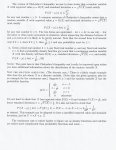BlueSourBalls
New member
- Joined
- Apr 5, 2018
- Messages
- 4
Chebyshev's Inequality: Given fixed k>1, fixed mu, fixed sigma>0, find g(x) so that
If there's anyone willing to help me out on this Chebyshev's inequality problem, please try question 1. Everything below the question is just information/tips on how to do it. Thank you
1. Given a fixed real number \(\displaystyle k\, >\, 1,\) any fixed real number \(\displaystyle \mu,\) and any fixed real number \(\displaystyle \sigma\, >\, 0,\) find a probability density function \(\displaystyle g(x)\) such that a continuous random variable \(\displaystyle X\) with this density will have \(\displaystyle E(X)\, =\, \mu,\) standard deviation \(\displaystyle \sqrt{V(X)\,}\, =\, \sigma,\) and satisfy the following:
. . . . .\(\displaystyle P\left(\big|X\, -\, \mu\big|\, \geq\, k\sigma \right)\, =\, \dfrac{1}{k^2}\)

If there's anyone willing to help me out on this Chebyshev's inequality problem, please try question 1. Everything below the question is just information/tips on how to do it. Thank you
1. Given a fixed real number \(\displaystyle k\, >\, 1,\) any fixed real number \(\displaystyle \mu,\) and any fixed real number \(\displaystyle \sigma\, >\, 0,\) find a probability density function \(\displaystyle g(x)\) such that a continuous random variable \(\displaystyle X\) with this density will have \(\displaystyle E(X)\, =\, \mu,\) standard deviation \(\displaystyle \sqrt{V(X)\,}\, =\, \sigma,\) and satisfy the following:
. . . . .\(\displaystyle P\left(\big|X\, -\, \mu\big|\, \geq\, k\sigma \right)\, =\, \dfrac{1}{k^2}\)

Last edited by a moderator:
